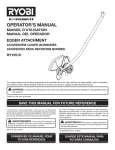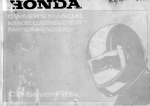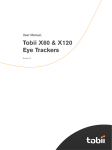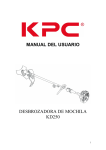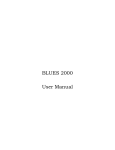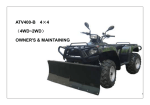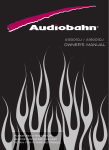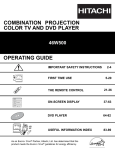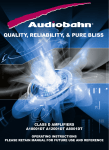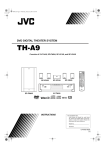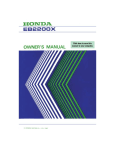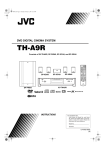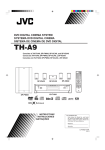Download owners manual.xlsx
Transcript
IMPORTANT NOTICE • OPERATOR AND PASSENGER This motorcycle is designed to carry the operator and one passenger. Never exceed the maximum weight capacity as shown on the tire information label. • ON-ROAD USE This motocycle is not equiped wiith a spark arrester and is designed to be used only on the road. Operation in forest, brush, or grass covered areas may be illegal. Obey local laws and regulations • READ THIS OWNER'S MANUAL CAREFULLY Pay special attention to statements proceded by the following words: Indicates severe personal injury or death will result if instructions are not followed. Indicates a strong possibility of personal injury or death will result if instructions are not followed. CAUTION: Indicates a possibility of perssonal injury or equpment damage if instructions are not followed. NOTE: Gives helpful information This manual should be considered a permanent part of the motorcycle and should remain with the motorcycle when resold. HONDA PACIFIC COAST PC800 OWNER'S MANUAL All infromation in this publication is based on the latest production information availiable at the time of approval for ptinting. HONDA MOTOR CO., LTD. Reserves the right to make changes at any time without notice and without incurring any obligation. No part of this publication may be reproduced without written permission. 1989 WELCOME Your new motorcycle presents you with an invitation to adventure and a challenge to master the machine. Your safety depends not only on your alertness and familiarity with the motorcycle, but also the motorcycle's mechanical condition. A pre-ride inspection before every outing and regular maintenance are essential. To help meet the challenges safely and enjoy the adventure fully, become thoroughly familliar with this Owner's Manual BEFORE YOU RIDE THE MOTORCYCLE. Also, for your own and your Honda's sake, please read all the writtern material which came with your new Honda. These items include: * Honda Owners Identification Card * Set-up and Predelivery Checklist * Honda Motorcycle Emission Control System, Distributors Warranty * Honda Motorcycle, Distributor's Limited Warranty * Honda Motorcycle Noise Control Systems, * Distributor's Warranty When service is required, remember that your Honda dealer knows what it takes to keep your Honda going strong. If you have the required mechanical "know-how" and tools, your dealer can supply you with an official Honda Service Manual to help you perfom many maintenance tasks. Pleasant riding, and thank you for choosing a Honda! CONTENTS OPERATION Page 1 MOTORCYCLE SAFTY 4 Safe Riding Rules 5 Protective Apparel 5 Modifications 6 Loading and Accessories 9 PARTS LOCATION 12 Instruments and Indicators 16 MAJOR COMPONENTS (Information you need to operate this motorcycle) 16 Rear Suspension 17 Brakes 20 Clutch 21 Coolant 23 Fuel 26 Engine Oil 28 Final Drive Oil 29 Tubeless Tires 32 ESSENTIAL INDIVIDUAL 32 COMPONENTS 33 Ignition Switch Right Handlebar Controls 34 Left Handlebar Controls 35 FEATURES (Not required 35 for operation) Steering Lock Page 35 37 38 39 Helmet Holder Trunk Fairing Pocket Rear View Mirror 41 41 42 45 46 48 49 49 OPERATION Pre-ride Inspection Starting the Engine Break-in Riding Braking Parking Anti-Theft Tips CONTENTS MAINTENANCE Page 50 MAINTENANCE 51 Maintenance Schedule 53 Maintenance Record 54 Tool Kit 54 Licence Plate 55 Serial Numbers 55 Color Label 56 Maintenance Precautions 57 Cover Removal 62 FILTERS/LUBRICATION 62 Engine Oil And Filter 64 Air Cleaner 66 ENGINE 66 Spark Plugs 68 Idle Speeds 69 DRIVE TRAIN 69 Final Drive Oil Page 70 70 74 77 78 FRAME/WHEELS/BRAKES Front Wheel Removal Rear Wheel Removal Brake Wear Indicators Side Stand 79 79 81 ELECTRICAL Battery Fuse Replacement 83 CLEANING 85 85 86 STORAGE GUIDE Storage Removal From Storage 87 SPECIFICATIONS CONSUMER INFORMATION (USA ONLY) 89 Emission Control System 91 Warranty Service 89 MOTORCYCLE SAFETY Read this WARNING INFORMATION before you ride! 1 MOTORCYCLE SAFETY 2 MOTORCYCLE SAFETY 3 MOTORCYCLE SAFETY SAFE RIDING RULES • Motorcycle riding requires special efforts on your part to ensure your safety. Know these requirements before you ride: 1. Always make a pre-ride inspection (page 41) before you ride the motorcycle. You may prevent an accident or equipment damage. 2. Many accidents involve inexperienced riders. Most states require a special motorcycle riding test or licence. Make sure you are qualified before you ride. NEVER lend your motorcycle to an inexperienced rider. 3. Many automobile/motorcycle accidents happen because the automobile driver does not "see" the motorcyclist. Make yourself conspicious to help avoid the accident that wasn't your fault: • Wear bright or reflective clothing. • Don't ride in another motorist's "blind spot." 4. Obey all federal, state, and local laws and regulations. • Excessive speed is a factor in many accidents. Obey the speed limits, and NEVER travel faster than conditions warrant. • Signal before you make a turn or lane change. Your size and maneuverability can surprise other motorists. 5. Don't let other motorists surprise you. Use extra caution at intersections, parking lot entrances and exits, and driveways 6. Keep both hands on the handlebars and both feet on the footpegs while riding. A passenger should hold on to the motorcycle or operator with both hands and keep both feet on the passenger footpegs. CAUTION: • Do not ride over curbs or rub the wheel against an obstacle, as wheel damage may result. 4 MOTORCYCLE SAFETY PROTECTIVE APPAREL 1. Most motorcycle accident fatalities are due to head injuries: ALWAYS wear a helmet. You should also wear a face shield or goggles as well as boots, gloves, and proective clothing. A passenger needs the same protection. 2. The exhaust system becomes hot during operation, and it remains hot for a while after stopping the engine. Be carefull not to touch the exhaust system while it is hot. Wear clothing that fully covers your legs. 3. Do not wear loose clothing which could catch on the control levers, footpegs, or wheels. MODIFICATIONS • Modifications of the motorcycle, or removal of original equipment, may render the vehicle unsafe or ilegal. Obey all federal, state and local equipment regulations. 5 MOTORCYCLE SAFETY LOADING AND ACCESSORIES • To prevent an accident, use extreme care when adding and riding with accessories and cargo. Addition of accessories and cargo can reduce a motorcycle's stabillity, perfomance and safe operating speed. Never ride an accessory-equipped motorcycle at speeds above 80 mph. And remember that this 80 mph limit may be reduced by installation of non-Honda accessories, improper loading, worn tires and overall motorcycle condition, poor road or weather conditions. These general guidelines may help you decide wether or how to equip your motorcycle, and how to load it safely. Loading The combined weight of the rider, passenger, cargo and additional accessories must not exceed * 67 kg (369 lbs), the maximum weight capacity. Cargo weight alone should not exceed 20 kg (44 lbs). 1. Keep cargo and accessory weight low and close to the center of the motorcycle. Load weight equally on both sides to minimize imbalance. As weight is located farther from the motorcycle's center of gravity, handling is proportionally affected. 2. Adjust tire pressure (page 2) to suit load weight and riding conditions. 3. All cargo and accessories must be secure for stable handling. Recheck cargo security and accessory mounts frequantily. 6 MOTORCYCLE SAFETY 4. Do not attach large, heavy items to the handlebars, front forks, or fender. Unstable handling or slow steering response may result. 5. Do not exceed the maximum weight capacity of Honda accessories. Trunk: 9 kg (20 lbs) Each side Fairing pocket: 0.5 kg (1 lbs) 6. The Honda fairing and trunk are designed for this motorcycle only. Do not install them on any other motorcycle. 7. Do not store articles between fairing and motorcycle. They may interfere with steering causing loss of control. Accessories Genuine Honda accessories have been specifically designed for and tested on this motorcycle. Because the factory cannot test all other accessories, you are personally responsible for proper selection, installation, and use of non-Honda accessories. Always follow the guidelines under loading, and these: 1. Carefully inspect the accessory to make sure it does not obscure any lights, reduce ground clearance and banking angle, or limit suspension travel, steering travel or control operation. 2. Large fork-mounted fairings or windshields, or poorly designed or improperly mounted fairings can produce aerodynamic forces that cause unstable handling. Do not install fairings that decrease cooling air flow to the engine. 7 MOTORCYCLE SAFETY 3. Accessories which alter your riding position by moving hands or feet away from controls may increase reaction time in an emergancy. 4. Do not add electrical equipment that will exceed the motorcycle's electrical system capacity. A blown fuse could cause a dangerous loss of lights or engine power. 5. This motorcycle was not designed to pull a sidecar or trailer. Handling may be serious impaired if so equipped. 6. Any modification of the cooling system may cause overheating and serious engine damage. Do not modify the radiator shrouds or install accessories which block or deflect air away from the radiator. 8 PARTS LOCATION 9 PARTS LOCATION 10 PARTS LOCATION 11 PARTS LOCATION INSTRUMENTS AND INDICATORS The indicators and warning lights are incorperated in the instrument panel. Their function are described on the following pages. USA model: Odometer reads in miles Canadian model: Odometer reads in kilometers. 12 PARTS LOCATION Speedometer: shows the riding speed. Tachometer: shows engine rpm. Never allow the tachometer needle to enter the red zone, even after the engine has been broken in. CAUTION: • The red zone indicates the maximum limits of the engine speed and running the engine in the red zone may adversely affect its service life. Turn Signal Indictors (amber) Flashes when the turn signal operates. Odometer Shows accumulated milage Tripometer Shows mileage per trip Tripmeter Reset Button Pushing the button resets the tripometer to zero (0) High beam Indicator (blue) Lights when the headlight is on high beam Neutral Indicator (green) Lights when the transmission is in neutral 13 PARTS LOCATION Oil Pressure Warning Light (red) Lights when engine oil pressure is below the normal operating range. Should also light when the ignition switch is ON and the engine is not running. Should go off when the engine starts, except for occasional flickering at or near idle speed when the engine is warm. CAUTION: • Running the engine with insufficient oil pressure may cause serious engine damage. Side Stand Indicator (amber) Lights when the side stand is put down. Before parking, check that the side stand is fully down; the light only indicates the side stand ignition cut-off system (page 78) is activated. Fuel Gauge (page 15) Shows approximate fuel supply available Coolant Gauge (page 15) Shows coolant temperature 14 PARTS LOCATION Fuel Gauge The fuel gauge shows the approximate fuel supply availiable. At F (Full) there are 16.0 litres (4.2 US gal.) , including the reserve supply. When the gauge needle enters the red band, the fuel level is low and you should refill the tank as soon as possible. The amount of fuel left in the tank when the needle enters the red band is approximately 3.0 liters (0.8 US gal.) Coolant Temperature Gauge The normal operating temperatutre gauge is the zone between the C (cold) and H 9hot0 marks. Wait for the temperature gauge needle to move above the C mark before riding. If the needle reaches the H mark, stop engine and check the reserve tank coolant level (page 21) Do not ride the motorcycle until the problem has been corrected. CAUTION: • Exceeding maximum running temperature may cause serious engine damage. 15 MAJOR COMPONENTS (Information you need to operate this motorcycle) • If the pre-ride inspection (page 41) is not performed severe personal injury or vehicle damage may result. Rear Suspension The left shock absorber has four adjustment positions for different load or riding conditions. The right shock is not adjustable. Use a handle to adjust the left shock. Position 2 is for light loads and smmooth road conditions. Positions 3 and 4 increase spring preload for a stiffer rear suspension, and can be used when the motorcycle is heavily loaded. 16 MAJOR COMPONENTS (Information you need to operate this motorcycle) BRAKES Front Brake This motorcycle has a hydraulic disk front brake. As the brake pads wear, the brake fluid level will drop. Therefore, the brake fluid level and pad wear must be inspected periodically. The system must be inspected frequently to ensure there are no fluid leaks. If the control lever or pedal free travel becomes excessive and the brake pads are not worn beyond the recommended limit (page 77), there is probebly air in the brake system and it must be bled. See your authorized Honda dealer for this service. Brake Fluid Level: • Brake fluid may cause irritation. Avoid contact with skin or eyes. In case of contact, flush thoroughly with water and call a doctor if you eyes were exposed. Brake fluid must be added to the reservoir whenever the fluid level begins to reach the lower level mark. Fill the reservoir with DOT 4 BRAKE FLUID from a sealed container up to the upper level mark. Reinstall the removed parts in the reverse order of removal. Tighten the screws securely. 17 MAJOR COMPONENTS (Information you need to operate this motorcycle) CAUTION: • Handle brake fluid with care because it can damage plastic and painted surfaces. • When adding brake fluid, be sure the reservoir is horizontal before the cap is removed or brake fluid may spill out. • Use only DOT 4 brake fluid from a sealed container. • Never allow contaminants such as dirt or water to enter the brake fluid reservoir. Other Checks: Make sure there are no fluid leaks. Check for deterioration or cracks in the hoses and fittings. Rear Brake Adjustment 1. Place the motorcycle on its center stand 2. The stopper bolt is provided to allow adjustment of the pedal height. To adjust the pedal height, loosen the lock nut and turn the stopper bolt. Tighten the lock nut. 3. Measure the distance the rear the brake pedal moves before the brake starts to take hold. 18 MAJOR COMPONENTS (Information you need to operate this motorcycle) Free play should be. 20 - 30 mm (3/4 - 1-1/4 in) If adjustment is necessary, turn the rear brake adjusting nut. NOTE: • Make sure the cut-out on the adjusting nut is seated on the brake arm pin after making the final free play adjustment. • If proper adjustment cannot be obtained by this method' see your authorized Honda dealer. 4. Apply the brake several times and check for free wheel rotation when released. 5. Check the adjustment has not activated the rear brake light even though there is no pressure on the brake pedal. Also check that pressure on the brake pedal. Also check that pressing down on the brake pedal does activate the rear brake light. Other Checks: Make sure the brake rod, brake arm, spring and fasteners are in good condition. 19 MAJOR COMPONENTS (Information you need to operate this motorcycle) CLUTCH This motorcycle has a hydraulically actuated clutch. There are no adjustments to perform but the clutch system must be inspected periodically for fluid level and leakage. If the control lever free play becomes excessive and the motorcycle creeps or stalls when shifting into gear, or if the clutch slips, causing acceleration to lag behind engine speed, there is probably air in the clutch system and it must be bled out. See your authorized Honda dealer for this service. Fluid Level Check that the fluid level is above the LOWER LEVEL LINE. If the fluid level is near the LOWER LEVEL LINE, it indicates fluid leakage. See your authorized Honda dealer for this service. Other Checks Make sure there are no fluid leaks. Check for deterioration or cracks in the hose and fittings. 20 MAJOR COMPONENTS (Information you need to operate this motorcycle) COOLANT Coolant Recommendation The owner must properly maintain the coolant to prevent freezing, overheating, and corrosion. Use only high quality ethylene glycol antifreeze containing corrsion protection inhibitors specially recommended for use in aluminium engines. (SEE ANTIFREEZE CONTAINER LABEL). CAUTION: • Use only low-mineral drinking water or distilled water as a part of the antifreeze solution. Water that is high in mineral content or salt may be harmfull to the aluminium engine. The factory provides a 50/50 solution of antifreeze and water in this motorcycle. This coolant solution is recommended for most operating temperatures and provides good corrosion protection. A higher concentration of antifreeze decreases cooling system performance and is recommended only when additional protection against freezing is needed. A concentration of less than 40/60 (40% antifreeze) will not provide proper corrosion protection. During freezing temperatures, check the cooling system frequantly and add higher concentrations of antifreeze (up to a maximum of 60% antifreeze) if required. 21 MAJOR COMPONENTS (Information you need to operate this motorcycle) Inspection Check the coolant level in the reserve tank while the engine is at normal operating temperature. Add coolant to the reserve tank as required to bring the coolant level to the UPPER level mark. If the reserve tank is empty, or if the coolant loss is excessive, check for leaks and see your authorised Honda dealer for repair, • Do not remove the radiator cap. When the engine is hot the coolant is under pressure and could scold you. • Keep hands and clothing away from the cooling fan, as it starts automatically 22 MAJOR COMPONENTS (Information you need to operate this motorcycle) FUEL Automatic Fuel ON-OFF Fuel will flow to the carburetors ony when the engine is started or is running. Fuel Tank Fuel tank capacity is 16.0 ltrs (4.2 US gal). Insert the ignition key and turn it clockwise to open the fuel filler compartment. Turn the fuel tank cap counterclockwise to remove it Your engine is designed to use any gasoline that has a pump octane number of 86 or higher, or that has a research octane number of 91 or higher. Gasoline pumps at service station normally displat the octane number. We recomend that you use unleaded fuel because it produces fewer engine and spark plug deposits and extends the life of exhaust components. Never use stale or contminated gasoline or an oil/gasoline mixture. Avoid getting dirt, dust or water in the fuel tank. Use of a lower octane gasoline can cause persistant "pinging" or heavy "spark knock" (a metallic rapping noise) which if severe, can lead to engine damage. CAUTION: • If "spark plug" knock or "pinging" occurs at a steady engine speed under normal load, change brands of gasoline. If spark knock or pining persists, consult your authorised Honda dealer. Failure to do so is considered misuse, and damage caused by misuse is not covered by Honda's Limited Warranty. Occasionally you may experiance light spark knock while operating under heavy loads. This is no cause for concern, it simply means your engine is operating efficiently. 23 MAJOR COMPONENTS (Information you need to operate this motorcycle) Install the fuel tank cap by turning it clockwise. (California model: Be sure to properly route the hose attached to the top of the cap.) Close the fuel filler compartment Lid with the key inserted and turned clockwise, then turn the key counterclockwise to lock the lid. • Gasoline is extremely flammable and is explosive under certain conditions. • Refuel in a well-ventilated area with the engine stopped. Do not smoke or allow flames or sparks in the area where the engine is refueled or where gasoline is stored • Do not overfill the tank (there should be no fuel in the filler neck). After refueling, make sure the tank cap is closed properly and securely. • Be carefull not to spill fuel when refueling. Spilled fuel or fuel vapor may ignite. If any fuel is spilled, make sure the area is dry before starting the engine. • Avoid repeated or prolonged contact wit skin or breathing of vapor. KEEP OUT OF THE REACH OF CHILDREN. 24 MAJOR COMPONENTS (Information you need to operate this motorcycle) Gasolines Containing Alcohol If you decide to use gasoline containing alcohol (gasohol), be sure its octane rating is at least as high as that recommended by Honda. There are two types of "gasohol": one containing ethanol, and the other containing methanol. Do not use gasohol that contains more than 10% ethanol. Do not use gasoline containing methanol (methyl or wood alcohol) that does not also contain cosolvents and corrosion inhibitors for methanol. Never use gasoline containing more than 5% methanol, even if it has consolvents ad corrosion inhbitors. Note: • Fuell system damage or engine performance problems resulting from the use of fuels that contain alcohol are not covered under the warranty. Honda cannot endorse the use of fuels containing methanol since evidence of their suitability is as yet complete. • Before buying fuel from an unfamiliar station, try to find if the fuel contains alcohol. If it does, confirm the type and percentage of alcohol used. If you notice any undesirable operating symptoms while using a gasoline that contains alcohol, or one that you think contains alcohol, switch to a gasoline that you know does not contain alcohol. 25 MAJOR COMPONENTS (Information you need to operate this motorcycle) ENGINE OIL Check engine oile level each day before operating the motorcycle. To check the oil level: 1. Place the motorcycle on its center stand on firm, level ground and remove the stepholder cover (page 60). 2. Start the engine and let it idle for a few minutes. 3. Stop the engine. After a few minutes, remove the dipstick and wipe ir clean, then reinsert the dipstick without screwing it in. The oil level should be between the upper and lower level marks on the dipstick. 4. If required,remove the filler cap, add the specified oil up to the upper level mark. Do not overfill. 5. Reinstall the filler cap, dipstick, and step holder cover. CAUTION: • Running the engine with insufficient oil can cause serious engine damage. 26 MAJOR COMPONENTS (Information you need to operate this motorcycle) Engine Oil Recommendation USE HONDA 4-STROKE OIL OR AN EQUIVALENT Use only high detergent, premium quality motor oil certified to meet US automobile manufacturer's requirements for Service Classification SE or SF Motor oils intended for Service SE or SF will show this designation on the container. The use of special oil additives is unnecessary and will only increase operating expenses. CAUTION: • Engine oil is a major factor affecting the performance and service life of the engine. Non-detergent, vegetable or castor based racing oils are not recommended. Recommended Oil Viscosity SAE 10W-40 Other viscosities shown in the chart below may be used when the average temperature in your riding area is within the indicated range. 27 MAJOR COMPONENTS (Information you need to operate this motorcycle) FINAL DRIVE OIL Oil Level Check Check the final drive oil level when specified by the maintenance schedule. 1. Place the motorcycle on its center stand on firm, level ground. 2. Remove the oil filler cap. 3. The oil level should be flush with the lower edge of the oil filler hole. NOTE : • If the level is low, check for leaks. Add the recommended oil through the oil filler hole until it reaches the lower edge of the opening. Recommended Oil: HYPOID GEAR OIL SAE 80 28 MAJOR COMPONENTS (Information you need to operate this motorcycle) TUBELESS TIRES This motorcycle is equiped with tubeless tires, valves, and wheel rims. Use only tires marked "TUBELESS" and tubeless valvea on rims marked "TUBELESS TIRE APPLICABLE." Never mount tires designed for use on automobiles on a motorcycle rim • Any attempt to mount passenger car tires on a motorcycle rim may cause the tire bead to seperate from the rim with enough explosive force to cause serious innjury or death. Proper air pressure will provide maximum stability, riding comfort and tire life. Check tire pressure frequantly and adjust if necessary (page 2) NOTE: • Tire pressure should be checked before you ride while the tires are "cold." • Tubeless tires have some degree of self-sealing ability if they are puctured, and leakage is often very slow. Inspect very closely for punctures, especially if the tire is not fully inflated. Check the tires for cuts, embedded nails or other sharp objects. Check the rims for dents or deformation. If there is any damage, see your authorized Honda dealer for repair, replacement, and balancing. • Improper tire inflation will causeabnormal tread wear and create a safety hazard. Underinflation may result in the tire slipping on, or coming of the rim causing tire deflation that may result in a loss of vehicle control. • Operation with excessively worn tires is hazardous and will adversely affect traction and handling. Replace tires before tread depth at the center of the tire reaches the limit as shown on the tire information label (page 2) or when the surface is flush with the wear indicators. 29 MAJOR COMPONENTS (Information you need to operate this motorcycle) Tire Repair/Replacement See your authorized Honda Dealer. • The use of tires other than those listed on the tire information label may adversely affect handling. • Do not install tube-type tires on tubeless rims. The beads may not seat and the tires could slip on the rims, causing tire deflation that may result in a loss of vehicle control. • Any attemp to mount passenger car tires on a motorcycle rim may cause the tire bead to separate from the rim with enough explosive force to cause serious injury or death. 30 MAJOR COMPONENTS (Information you need to operate this motorcycle) • Do not install a tube inside a tubeless tire. Excessive heat build-up may cause the tube to burst resulting in rapid tire deflation that may result in a loss of vehicle control. • Proper wheel balance is necessary for safe, stable handling of the motorcycle. Do not remove or change any wheel balance weights. When wheel balancing is required, see your authorized Honda dealer. Wheel balancing is required after tire repair or replacement. • To avoid possible repair faliure and tire deflation that may result in a loss of vehicle control, do not exceed 50 mph for the first 24 hours, or 80 mph at any time,after tire repair. • Replace the tire if the sidewall is punctured or damaged. Sidewall flexing may cause repair faliure and tire deflation that may result in loss of vehicle control. CAUTION: • Do not try to remove tubeless tires without special tools and rim protectors. You may damage the rim sealing surface or disfigure the rim. 31 ESSENTIAL INDIVIDUAL COMPONENTS IGNITION SWITCH The ignition switch is on the handlebar cover. 32 ESSENTIAL INDIVIDUAL COMPONENTS RIGHT HANDLEBAR CONTROLS Engine Stop Switch The two positions engine stop switch is next to the throttle grip. When the switch is in the RUN position, the engine will operate. When the switch is in the OFF position, the engine will not operate. This switch is intended primarily as a safety or emergancy switch and should normally remain in the RUN position NOTE: • If your motorcycle is stopped with the ignition switch ON and the engine stop switch OFF, the headlight and taillight will still be on, resulting in battery discharge. Starter Button The starter button is below the engine stop switch. When the starter button is pressed, the starter will crank the engine and the headlight will automatically go off, but the taillight will stay on. See pages 42 - 44 for "Starting Procedure." 33 ESSENTIAL INDIVIDUAL COMPONENTS LEFT HANDLEBAR CONTROLS The controls next to the left handlebar grip are: Headlight Dimmer Switch Select HI for high beam LO for low beam. Horn Button Press the button to sound the horn. Turn Signal Switch Move the switch to L to signal a left turn, to R to signal a right turn; the appropriate turn signal and indicator will blink. The switch returns to the center when it is released. The indicator will automatically stop blinking upon completing the turn. 34 FEATURES (Not required for operation) STEERING LOCK To lock the steering, turn the handlebar all the way to the left or right, turn the key to LOCK while pushing in. Remove the key. • Do not turn the key to LOCK while riding the motorcycle; loss of vehicle control may result. HELMET HOLDER The helmet holder lock is stored in the trunk. The lock's combination is preset to 0 - 0 - 0 - 0, you may use this combination or select your own. To Use: 1. open the trunk (page 37), and remove the combination lock. 2. Run the cable end through the D-ring of the helmet(s) and both passenger side grips, then insert it in the lock end. FEATURES (Not required for operation) • The helmet holder is designed for helmet security while parked. Do not ride with a helmet attached to the holder; the helmet may interfere with safe operation and result in loss of control. To Set Combination 1. Pull the cable end out of the lock end. 2. Remove the cone by turning it a quarter turn (90⁰) counterclockwise. Remove the four lock wheels. 3. You can now set the combination. Align the red marks with the guide point on the cone. Replace the lock wheels one at a time. Lining up your selected numbers with the guide point on the cone. CAUTION: • Reversing the wheels will cause the lock to jam. 4. After positioning all four lock wheels, place the cone onto the lock housing and turnit a quarter turn (90⁰) clockwise. 36 FEATURES (Not required for operation) TRUNK To open the trunk Insert the ignition key and turn it clockwise to open the fuel filler compartment. Pull the latch lever to open the trunk. To lock the trunk Close the trunk lid. Make sure the trunk is locked. • The trunk is for lightweight items. Do not carry more than 9 kg (20 lbs) in each side. Excessive weight may adversely affect vehicle handling and control. • Load weight equally in both sides to minimize an imbalance that may result in a loss of vehicle control. • Review Loading and Accessories (page 6) before loading. CAUTION: • Closing the trunk lid with items placed in the damper channel or behind the damper may damage the damper. • Directing water under pressure against the trunk can force water into the trunk. NOTE: • Items placed in the trunk may be subject to high temperatures under certain conditions. 37 FEATURES (Not required for operation) • The damper unit contains high pressure nitrogen gas. Do not attempt to disassemble, disconect or service the damper unit; an explsion causing serious injury may result. • Puncture or exposure to flame may also result in an explosion causing serious injury • Service or disposal should only be done by your authorized Honda dealer. FAIRING POCKET To open the left fairing pocket lid, slide the button forward and open the lid. • The fairing pocket is for lightweight items. Do not carry more than 0.5 kg (1 lbs). • Review Loading and Accessories before handling (page 6). 38 FEATURES (Not required for operation) REAR VIEW MIRRORS Both rear veiw mirrors use a special breakaway mount which allows a controlled seperation fo the mirror from its base upon impact with an obstacle. A short steel cable keeps the mirror connected to the mirror bracket. Installation 1. Remove the two bolts fastening the mirror base to the body. Remove the base. 2. Remove the three screws from the mirror bracket. 3. Position the mirror base on the mirror bracket and install using the three screws removed in step 2. 39 FEATURES (Not required for operation) 4. Insert the retaining tabs of the body in the forward grooves of the mirror base. Install the two bolts removed in step 1. 5. After reinstalling, check the mirror for correct angle and the front turn signals for proper operation. CAUTION: • Riding with a mirror hanging by its retaining cable may damage the motorcycle's body. NOTE: • For your safety, be sure to immediatly reassemble any seperated mirror. Otherwise, the mirror and turn signal will not be availiable to you while riding, If a mirror is damaged so badly that it cannot be reused or reinstall on its base, remove it from the base and transport the motorcycle to an authorized Honda dealer. 40 FEATURES (Not required for operation) PRE-RIDE INSPECTION • If the pre-ride inspection is not performed, severe personal injury or vehicle damage may result. Inspect your motorcycle every day before you ride. The items listed here will only take a few minutes to inspect, and in the long run can save time, expense, and possibly your life. 1. Engine oil level - add engine oil if required (page 26). Check for leaks. 2. Fuel level - fill fuel tank when necessary (page 23). Check for leaks. 3. Coolant level - add coolant if required. Check for leaks (pages 21 - 22). 4. Front and rear brakes - check operation; make sure there is no brake fluid leakage. Adjust free play if necessary (pages 17 - 19, 77). 5. Tires - check condition (page 29 - 31) and pressure (page 2). 6. Throttle - check for smooth opening and closing in all steering positions. 7. Lights and horn - check that headlight, taillight/stoplight, turn signals, indicators and horn function properly. 8. Engine stop switch - check for proper function (page 33). 9. Side stand ignition cut-off system - check for proper function (page 78). Correct any discrepancy before you ride. Contact your authorized Honda dealer for assistance if you cannot correct the problem. 41 OPERATION STARTING THE ENGINE This motorcycle is equipped with a side stand ignition cut-off system. The engine cannot be started if the side stand is down, unless the transmission is in neutral. If the side stand is up, the engine can be started in neutral or gear with the clutch lever pulled in. After starting with the side stand down' the engine will stop if the transmission is put in gear. • Never run the engine in a closed area. The exhaust contains poisonous carbon monoxide gas that can cause loss of consciouness and may lead to death. • Do not flood the engine by twisting the throttle repeatedly. The carburetor has no accelerator pump. NOTE: • Do not use the electric starter for more than 5 seconds at a time. Release the starter button for approximatley 10 seconds before pressing it again. Preperation Before starting, insert the ignition key, turn the ignition switch ON and confirm the following; • The transmission is in NEUTRAL (neutral indicator light ON). • The engine stop switch is at RUN. • The red engine oil pressure warning light is ON. CAUTION: • The red oil pressure warning light should go off a few seconds after the engine starts. If the light stays on, stop the engine immediately and check engine oil level. Operating the engine with insufficient oil pressure can cause serious engine damage. 42 OPERATION Starting Procedure To restart a warm engine, follow the procedure for "High Air Temperature." Normal Air Temperature 10⁰ - 35⁰C (50⁰ - 95⁰F): 1. Pull the choke lever up all the way to fully On (B) 2. Start the engine, leaving the throttle closed. NOTE: • Do not open the throttle when starting the engine with the choke on. This will lean the mixture resulting in hard starting. 3. Immediately after the engine starts, operate the choke lever to keep fast idle at 1,500 - 2,500 rpm. 4. About a half minute after the engine starts, push the choke lever down all the way to Fully Off (A). 5. If idling is unstable, open the throttle slightly. High Air Temperature 35⁰C (95⁰F) or above: 1. Do not use the choke. 2. Open the throttle slightly. 3. Start the engine. 43 OPERATION Low Air Temperature 10⁰C (50⁰F) or below: 1. Follow steps 1 - 2 under "Normal Air Temperature." 2. Warm up the engine by opening and closing the throttle slightly. 3. Continue warning up the engine until it runs smoothly and responds to the throttle when the chole lever is at Fully Off (A). CAUTION: • Extended use of choke may impair piston and cylinder wall lubrication. Flooded Engine If the engine fails to start after repeated attempts, it may be flooded with excess fuel. To clear a flooded engine, turn the engine stop switch OFF and push the choke lever down to Fully Off (A). Open the throttle fully and crank the engine for 5 seconds and follow the "High Air Temperature" Starting Procedure (page 43). 44 OPERATION BREAK-IN During initial break-in, newly machined surfaces will be in contact with each other and these surfaces will wear inn quickly. Break-in maintenance at 1,000 km (600 mls) is designed to compensate for this initial minor wear. Timely performaance of break-in maintenance will ensure optimum service life and performance from the engine. The general rules are as follows: 1. Never lug the engine wiithh full throttle at low engine speeds. This rule is applicablenot only during reak-in bbut at all times. 2. Maximum continous engine speed during the first 1,000 km (600 miles) must not exceed 4,000 rpm. 3. Increase the maximum continuous engine speed by 1,000 rpm between odometer readings of 1,000 km (600 miles) and 1,600 km (1,000 miles). Drive briskly, vary speeds frequantly and use full throttle for short bursts only. Do not exceed 6,000 rpm. 4. Upon reaching an odometer reading of 1,600 km (1,000 miles) you can subject the motorcycle to full throttle operation. However, do not exceed 7600 rpm at an time (tachometer RED BAR limit). CAUTION: • The red bar indicates the maimum limit of engine speed and running the engine in the red bar will adversly affect its service life. 45 OPERATION RIDING Review Motorcycle Safty (pages 1 - 8) before you ride. • Riding with an unlocked trunk may result in loss of vehicle control. Be sure the trunk lid is closed secuely before riding. Proper shifting will provide better fuel economy. When changing gears under normal conditions, use these recommended shift points: Shifting Up: From 1st to 2nd 6 mph (10 km/h) From 2nd to 3rd 12 mph (20 km/h) From 3rd to 4th 19 mph (30 km/h) From 4th to 5th 25 mph (40 km/h) Shifting Down: From 5th to 4th 22 mph (35 km/h) From 4th to 3rd 16 mph (25 km/h) Disengage the clutch when speed drops below 9 mph (15 km/h), when engine roughness is evident, or when engine stalling is imminent; and shift down to 1st gear for acceleration. 46 OPERATION • Do not downshift when traveling at a speed that would force the engine to overrev in the next lower gear; the rear wheel may loose traction, resulting in possible loss of vehicle control. CAUTION: • Do not shift gears without disengaging the clutch and closing the throttle. The engine and drive chain could be damaged by overspeed and shock. • Do not tow the motorcycle or coast for long distances while the engine is off. The transmission will not be properly lubricated and damage may result. • Do not exceed 7600 rpm when running the engine without a load. Serious engine damage may result. NOTE: • Be careful when revving the engine or accelerating in 1st or 2nd gear as the engine speed will easily enter the red bar. 47 OPERATION BREAKING Your motorcycle is equipped with independent front and rear brakes. Braking Safety - - Independent use of only the front or rear brake increases stopping distance. If too much force is applied to the brake it will lock, resulting in tire skid and possible loss of control. - - When possible, reduce speed or brake before entering a turn. Closing the throttle or braking in mid-turn may cause tire skid and loss of control. - - When riding in wet or rainy conditions, or on loose surfaces, your ability to maneuver and stop will be reduced. All of your actions should be smooth under these conditions. Sudden throttle application, braking or turning can cause a loss of control. For your safety, exercise extreme caution in adverse conditions. - - When descending a long, steep grade, use "engine braking" by downshifting and using both brakes intermittently. Continuous application can cause overheating and eventual brake faliure. - - Riding with your foot resting on the brake pedal, or your hand on the breke lever, may activate the brake light, giving a false indication to other drivers. It may also overheat the brake, reducing its effectiveness. For normal braking, gradually apply both front and rear brakes while downshifting to suit your road speed. For maximum deceleration, close the throttle and apply the front and rear brakes firmly. Disengage the clutch before the motorcycle stops. 48 OPERATION PARKING 1. After stopping the motorcycle, shift the transmission into neutral, turn the ignition switch OFF and remove the key. 2. Use the side or center stand to support the motorcycle while parked. CAUTION: • Park the motorcycle on firm, level ground to prevent it from falling over. 3. Lock the steering to help prevent theft (page 35). NOTE: • When stopping for a short time near traffic at night, the ignition switch may be turned to P and the key removed. This will turn on the taillight to make the motorcycle more visible to traffic. The battery will discharge if the ignition switch is left at P for too long a time. ANTI-THEFT TIPS 1. Always lock the steering and never leave the keys in the ignition switch. This sounds simple but people do forget. 2. Be sure the registration information for your motocycle is accurate and current. 3. Park your motorcycle in a locked garage whenever possible. 4. Use an additional anti-theft device of good quality. 5. Put your name, address, and phone number, in this Owner's Manual and keep it in your motorcycle at all times. Many times stolen motorcycles are identified by information in the Owner's Manuals that are still with them. 49 MAINTENANCE • The U.S. Environmental Protection Agency and California Air Resources Board (CARB) require that your motorcycle comply with applicable exhaust emissions standards during its usefull life, when operated and maintained according to the instructions provided, and that motorcycles built after January 1, 1983 comply with applicable noise emission standards for one year or 6,000 km (3,730 miles) after the time of sale to the ultimate purchaser, when operated and maintained according to the instructions provided. Compliance with the terms of the Distributor's Warrenties for Honda Motorcycle Emission Control Systems is Necessary in order to keep the emissions system warranty in effect. (USA only) • When service is required, remember that your authorized Honda dealer knows your motorcycle best and is fully equipped to maintain and repair it. The scheduled maintenance and the anticipated maintenance may also be performed by a qualified service facility that normally does this kind of work; or you may perform most of the work yourself if you are mechanically qualified and have the proper tools and service data. • These instuctions are based on the assumption that the motorcycle will be used exclusively for its designed purpose. Sustained high speed operation or operation in unusually wet or dusty conditions will require more frequent service than specified in the MAINTENANCE SCHEDULE. Consult your authorized Honda dealer for recommendations applicable to your individual needs and use. 50 MAINTENANCE MAINTENANCE SCHEDULE Perform the Pre-ride inspectiion (page 41) at each scheduled maintenance period. I : INSPECT AND CLEAN, ADJUST, LUBRICATE OR REPLACE IF NECESSARY C : CLEAN R: REPLACE A: ADJUST L: LUBRICATE The following items require some mechanical knowledge. Certain items (particularly marked • and ••) may require more technical information and tools. Consult your authorized Honda dealer. 51 MAINTENANCE • SHOULD BE SERVICED BY AN AUTHERIZED HONDA DEALER. UNLESS THE OWNER HAS PROPER TOOLS AND SERVICE DATA AND IS MECHANICALLY QUALIFIED. REFER TO THE OFFICIAL HONDA SERVICE MANUAL. •• IN THE INTEREST OF SAFTY, WE RECOMMEND THESE ITEMS BE SERVICED ONLY BY AN AUTHORIZED HONDA DEALER. NOTES: 1. At higher odometer readings, repeat at the frequancy interval established here. 2. Service more frquantly when riding in unusually wet or dusty areas. 3. California type only. 4. Replace every 2 years, or at the indicated odometer intervals, whichever comes first. Replacement requires mechanical skill. 52 MAINTENANCE • Make sure whoever performs the maintenance completes this record. All scheduled maintenance, including the 600 mile (1,000 km) break-in maintenance, is considered a normal owner operating cost and will be charged for by your dealer. • Detailed receipts verifying the performance of required maintenance should be retained. These receipts should be transfered with the motorcycle to the new owner if the motorcycle is sold. 53 MAINTENANCE TOOL KIT The tool kit is in the trunk.Someroadside repairs, minor adjustments and parts replacement can be performed with the tools contained in the kit. • Spark plug wrench • 10 x 12 mm Box end wrench • 22 mm Box end wrench • 27 mm Box end wrench • 10 x 12 mm Open end wrench • 14 x 17 mm open end wrench • Fuse puller • Phillips screwdriver • Screwdriver handle • Screwdriver • Handle grip • Handle • 5 mm Hex wrench • 6 mm Hex wrench • 8 mm Hex wrench • 10 mm Hex wrench • 0.7 mm Feeler gauge • Tool bag LICENSE PLATE To install a license plate: remove the license plate bracket nuts, install the license plate on the bracket and reinstall the bracket. 54 MAINTENANCE SERIAL NUMBERS The frame and engine serial numbers are required when registering the motorcycle. They may also be required by your dealer when oredering replacement parts. Record the numbers here for your reference. The VIN, Vehicle Identification Number, is on the Safety Certification Label attached to the frame, near the steering head. The frame number is stamped on the right side of the steering head. The engine number in stamped on the right side of the crankcase, under the side cover. COLOR LABEL The color label is attached inside the fuel filler compartment lid. It is helpful when ordering replacement parts. Record the color and code here for your reference. VIN. FRAME NO. ENGINE NO. COLOR. CODE. 55 MAINTENANCE MAINTENANCE PRECAUTIONS • If your motorcycle is overturned or involved in a collision, inspect control levers, cables, brake hoses, calipers, accessories, and other vital parts for damage. Do not ride the motorcycle if damage impairs safe operation. Have your authorized Honda dealer inspect the major components, including frame, suspension and steering parts, for misalignment and damage that you may not be abel to detect. • Stop the engine and support the motorcycle securely on a firm, level surface before performing any maintenance. • Use new, genuine Honda parts or their equivalent for maintenance or repair. Parts which are not of equivalent quality may impair the safty of your motorcycleand the effective operation of the emission control system. The Vehicle Emission Control Information label is attached to the right side of the frame under the right cover. The Vacuum Hose Routing Diagram is attached to the fuel tank under the left side cover (California only). 56 MAINTENANCE 57 MAINTENANCE 1. Air Duct/Maintenance Cover Release the clips (2) by gripping the edge (1) of the air duct end and pulling it out toward you. Remove the air duct by pulling it backward. NOTE: • The exhaust becomes very hot during operation and remains hot after stopping the engine. Do not bring the cover into contact with the exhaust pipe when removing it. 2. Side Cover Remove screw (1). Disconnect the side cover from the end (2) of the upper cowl by sliding it backward. Pry the cover out toward you to release the retaining tabs (3) from the top shelter and the two retaining tabs (4) from the lower cover. 58 MAINTENANCE 3. Fairing Protector Remove the screw (1), then while squeezing the edge (2) pull the protector out and back toward you. 4. Front Lower Cover Remove both screws (1) and release the tab, do the same on the other side, then slide the cover forward. 59 MAINTENANCE 5. Step Holder Cover Unfold th passenger foot peg (1). Holding the opening edge (2) of the holder cover with your fingers, pull the cover (3) out, then slide it to the rear. 6. Saddlebag Protector Simultaneously squeeze the edge (1) and pull the protector toward you 60 FILTERS/LUBRICATION 7. Rear Lower Covers Open the trunk lid, then remove the bolts (1). Release the retaining hook (2) at the rear of the cover. With the passenger footpeg unfolded, pull the rear of the cover out toward you to clear the passenger footeg. Pull the front of the cover out also toward you until it clears of the brake pedal (4). 8. Left Side Cover Removal Removal of the left side covers is essentially the same. However, it is necessary to remove an additional bolt, the chamber cover bolt (1), to remove the lower cover. 61 FILTERS/LUBRICATION ENGINE OIL AND FILTER Refer to Maintenance Precautions on page 56. Engine oil quality is the chief factor affecting engine service life. Change the engine oil as specified in the maintenance schedule on page 51. CAUTION • Used engine oil may cause skin cancer if repeatedly left in contact with the skin for prolonged periods. Although this is unlikely unless you handle oil on a daily basis, it is still advisable to thoroughly wash your hands with soap and water as soon as possible after handling used oil. NOTE • Please dispose of used engine oil in a manner that is compatible with the enviroment. We suggest you take it in a sealed container to your local service station for reclamation. Do not throw it in the trash or pour it on the ground. • Change the engine oil with the engine at normal operating temperature and the motorcycle on its center stand to assure complete and rapid draining. To drain the oil: 1. Remove the step holder cover, (pages 57, 60), the oil filler cap and drain bolt. 62 FILTERS/LUBRICATION 2. Remove the oil filter with a filter wrench. Discard the oil filter. 3. Apply a thin coat of engine oil to the rubber seal on the new oil filter. 4. Install the new oil filter and tighten it to the specified torque: 10 N-m (1.0 kg-m, 7 ft-lb) 5. Check that the sealing washer on the drain plug is in good condition. Install the drain plug and tighten to the specified torque: 35 N-m (3.5 kg-m 25 ft-lb) 6. Fill the crankcase with approximately 3.0 liters (3.2 US qt) of the recommended oil. 7. Install the oil filler cap. 8. Start the engine and let it idle for a few minutes. 9. Stop the engine. Make sure the oil level is at the upper level mark on the dipstick (page 26) and there are no oil leaks NOTE: • When running in very dusty conditions, oil changes should be performed more frequantly than specified in the maintenance schedule. 63 FILTERS/LUBRICATION AIR CLEANER The number indicates the sequance of disassembly. Remove the air duct/maintenance cover and side cover (pages 57 - 58). 64 FILTERS/LUBRICATION Refer to Maintenance Precautions on page 56. The air cleaner should be serviced at regular intervals (page 51). Service more frequantly when riding in unusually wet or dusty areas. 1. Remove the parts in sequance, according to the order in the illustration. NOTE: • Be careful not to break any tabs. 2. Remove the air cleaner element and discard it. 3. Install a new air cleaner element. 4. Install removed parts in the reverse order of removal. NOTE: • Make sure to engage all tabs and to secure all fasteners. 65 ENGINE SPARK PLUGS Refer to Maintenance Precautions on page 56. 1. Remove the air duct/maintenance cover and side cover (pages 57 - 58). (Right side shown; left side similar). 66 ENGINE Recomemded plugs: Standard: DPR7EA-9 (NGK), X22EPR-U9 (ND) For cold climate: (Below 5⁰C/41⁰F) DPR6EA-9 (NGK), X20EPR-U9 (ND) For extended high speed riding: DPR8EA-9 (NGK), X24EPR-U9 (ND) 2. Disconnect the spark plug caps. 3. Clean any dirt from around the spark plug base. 4. Remove and discard the spark plugs. 5. Make sure the new spark plug gap is 0.8 - 0.9 mm (0.031 - 0.035 in) using the 0.8 mm feeler gauge. If adjustment is necessary, bend the electrode carefully. 6. With the plug washers attached, thread the new spark plugs in by hand to prevent cross threading. 7. Tighten the spark plugs 1/2 turn with a spark plug wrench to compress the washer. 8. Reinstall the spark plug caps. CAUTION: • The spark plug must be securely tightened. An improperly tightened plug can become very hot and possibly damage the engine. • Never use a spark plug with an improper heat range. Severe engine damage could result. • When installing body parts, do not pinch any cables or wires. 67 ENGINE IDLE SPEED Refer to Maintenance Precautions page 56. The idle speed adjustment procedure given here should only be used when changes in altitude affect normal idel speed as set by your dealer. See your authorized Honda dealer for regularly scheduled carburetor adjustments, including individual carburetor adjustment and synchronization. NOTE: • The engine must be at normal operating temperature for accurate idle speed adjustment. Ten minutes of stop and go riding is sufficient. 1. Warm up the engine, shift to neutral and place the motorcycle on its center stand. 2. Open the fuel filler compartment. 3. Adjust the idle speed with the adjusting knob. Idle speed: 1200 ± 100 rpm (in neutral) 68 DRIVE CHAIN FINAL DRIVE OIL Refer to Maintenance Precautions page 56. Change the oil as specified in the maintenance schedule page 52. NOTE: • Change the oil with the final drive at normal operating temperature and the motorcycle upright on firm, level ground to assure complete and rapid draining. 1. To drain the oil, remove the oil filler cap and drain plug. 2. After th oil has completely drained, check that the sealing washer on the drain plug is in good condition and install the drain plug. Drain Plug Torque: 12N-m ((1.2 kg-m, 9 ft-lb) 3. Fill the final drive with approximatley 150cc (5.1 oz) of the recommended oil. Make sure the final drive oil level is slightly lower than the lower edge of the inspection hole. 4. Install the oil filler cap. Recommended oil: HYPOID GEAR OIL SAE 80 69 FRAME/WHEELS/BRAKES FRONT WHEEL REMOVAL For related torque specifications, see page 73. The numbers indicate the sequance of disassembly. 70 FRAME/WHEELS/BRAKES • Wheel removal requires mechanical skill and professional tools such as a floor jack and torque wrench. We recommend it be done only by yout authorized Honda dealer or other qualified mecahnic. NOTE: • For some temporary tubeless tire repairs, wheel removal may not be necessary. See pages 30, 31. Refer to Maintenance Precautions page 56. 1. Raise the front wheel off the ground by placing a support block under the engine. 2. Remove the parts in sequence, according to the order in the illustration. CAUTION: • To avoid damage to the brake hose, support the caliper assembly so that it doesn't hang from the hose. Do not twist the brake hose. • Avoid getting grease, oil or dirt on the disk or pad surfaces, because such contamination can cause poor brake performance or rapid brake wear after reassembly. NOTE: • Do not depress the brake lever when the wheel is off the motorcycle. The caliper pistons will be forced out of the cylinder with subsequant loss of brake fluid. If this occurs, servicing of the brake system will be necessary. See your Honda dealer for this service. 71 FRAME/WHEELS/BRAKES Installation 1. Reassemble removed parts in the reversr order of removal. NOTE: • When installing the wheel, position the speedometer gearbox so that the lug on the gearbox is against the rear of the stopper lug on the left fork. CAUTION: • When installing the wheel, fit both brake discs carefully between the brake pads to avoid damaging the pads. 2. Measure the clearence between the outside surface of the left brake disc and the left caliper holder with a 0.7 mm (0.028 in) feeler auge. If the gauge inserts easily, tighten the right and left axel pinch bolts to the specified torque. 72 FRAME/WHEELS/BRAKES Specified torque: Axel bolt: 90 N-m (9.0 kg-m, 65 ft-lb) Axel pinch bolt: 27 N-m (2.7 kg-m, 20 ft-lb) • If a torque wrench was not used for installation, see your authorized Honda dealer as soon as possible to verify proper assembly. Improper assembly may lead to loss of braking capacity. 3. If the feeler gauge cannot be inserted easily, pull the left fork outward or push inward until the gauge can be inserted and tighten the axel pinch bolt with the gauge inserted. 4. After tightening, remove the gauge. After installing the wheel, apply the brake several times, then recheck both discs for caliper-holder-to-disc clearence. Do not operate the motorcycle without adequate clearence. • Faliure to provide adequate disc-to-caliper-holder clearence may damage the brake disc and impair braking efficiency. 73 FRAME/WHEELS/BRAKES BRAKE WHEEL REMOVAL For related torque specifications, see page 76. The numbers indicate the sequance of disassembly. 74 FRAME/WHEELS/BRAKES • Wheel removal requires mechanical skill and professional tools such as a torque wrench. We recommend it be done only by your authorized Honda dealer or other qualified mechanic. NOTE: • For some temporary tubeless tire repairs, wheel removal may not be necessary. See pages 30 - 31. Refer to Maintenance Precautions on page 56. 1. Place the motorcycle on its center stand. 2. Remove the parts in sequance, according to the order in the illustration. Installation Notes: • Before installing the rear wheel, check that the wheel hub and final drive gear splines are coated in grease. • Reverse the removal procedure. • Be sure the splines on the wheel hub fit into the final gear case. • Before tightening the axel holding bolt, tighten the axel nut to prevent misalignment. 75 FRAME/WHEELS/BRAKES • Tighten and torque the following nuts and bolts: Axel nut torque: 110 N-m (11.0 kg-m, 80 ft-lb) Axel holding bolt torque: 27 N-m (2.7 kg-m, 20 ft-lb) Brake stopper arm nut torque: 22 N-m (2.2 kg-m, 16 ft-lb) • Apply the brake several times and check for free wheel rotation when released. • If a torque wrench was not used for installation, see your authorized Honda dealer as soon as possible to verify proper assembly. Improper assembly may lead to loss of braking capacity. CAUTION: • Always replace used cotter pins with new ones. 76 FRAME/WHEELS/BRAKES BRAKE WEAR INDICATORS Refer to Maintenance Precautions page 56. Brake Pad Wear Brake pad wear will depend upon the severity of usage, type of riding and conditions of the roads. The pads will wear faster on dirty and wet roads. Inspect the pads visually from under the caliper during all regular service intervals to determin the pad wear. If either pad wears to the wear line, both pads must be replaced as a set. Brake Shoe Wear The rear brake is equipped with brake wear indicator. When the brake is applied, an arrow attached to the brake arm moves forward toward a reference mark on the brake panel, if the arrow aligns with the reference mark on full application of the brake' the brake shoes must be replaced. 77 FRAME/WHEELS/BRAKES SIDE STAND Refer to Maintenance Precautions page 56. Check the side stand system for proper function. • Check the spring for damage or loss of tension and the side stand assembly for freedom of movement. • Check the side stand ignition cut-off system 1. Sit astride the motorcycle; put the side stand up and the transmission in neutral. 2. Start the engine and with the clutch lever pulled in, shift the transmission into gear. 3. Move the side stand fully down. 4. The engine should stop as you put the side stand down. If the side stand system does not operate as descibed, see your authorized Honda dealer for service. 78 ELECTRICAL BATTERY It is not necessary to check the battery electrolyte level or add distilled water as the battery is a maintenance-free (sealed) type. If the battery loses electrolyte and/or seems weak (causing hard starting or other electrical troubles), contact your authorized Honda dealer. CAUTION: • Do not attempt to remove the sealing caps from the cells- you may damage the battery. • When the motorcycle is to be stored for an extended period of time, remove the battery and charge it fully. Then store it in a cool dry place. • The battery gives of explosive gases; keep sparks, flames and cigarettes away. Provide adequate ventilation when charging or using the batteries in an enclosed area. • The battery contains sulfuric acid (electrolyte). Contact with skin or eyes may cause severe burns. Wear protective clothing and a face shield. - if electrolyte gets on your skin, flush with water. - if electrolyte gets on your eyes, flush with water for at least 15 minutes and call a physician immediately. • Electrolyte is poisonous. - If swallowed, drink large quantities of water or milk and follow with milk of magnesia or vegtable oil and call a physician. • KEEP OUT OF THE REACH OF CHILDREN. 79 ELECTRICAL Battery Removal The battery is located in the battery box below the rear seat. 1. Remove the air duct/maintenance cover side cover, fairing protector step holder cover, saddlebag protector and rear lower cover (pages 57 - 61). 2. Remove the battery holder by removing the bolt. 3. Disconnect the negative (-) terminal lead from the battery first. 4. Pull the battery out of the battery box. 5. Disconnect the positive (+) terminal lead. 80 ELECTRICAL FUSE REPLACEMENT Refer to Maintenance Precautions on page 56. The main fuse is, located on the starter magnetic switch under the seat is 30 A. The spare main fuse is under the starter magnetic switch. The fuse box is located under the left side cover. The air duct/maintenance cover must be removed before removing the left side cover. The specified fuses are 10 A and 15 A. When frequant fuse faliure occurs, it usually indicates a short vircuit or an overload in the electrical system. See your authorized Honda dealer for repair. CAUTION: • Turn the ignition switch OFF before checking or replacing fuses to prevent accidental short-circuiting. To replace the main fuse, open the trunk and remove the seat by removing bolts. Disconnect the wire connector of the starter magnetic switch and pull out the old fuse. Install a new fuse and reconnect the connector. 81 ELECTRICAL To replace the fuses in the fuse box: remove the left side airduct/maintenance cover and the side cover ( pages 57 - 58). The spare fuses are located in the trunk. Pull the old fuses out the clips with the fuse remover. Push a new fuse into the clips and install the fuse box cover. • Never use a fuse with with a different rating from that specified. Serious damage to the electrical system or a fire may result, causing a dangerous loss of lights or engine power. 82 CLEANING Clean your motorcycle regularly to protect the surface finishes and inspect for damage, wear, and oil, coolant, or hydraulic fluid seepage. 1. Clean the windshield with a soft cloth or sponge and plenty of water. Dry with a soft clean cloth. Remove minor scratches with commercially availiable plastic polishing compound' Replace the windshield if scratches cannot be removed and they obstruct clear vision. CAUTION: • Do not let battery electrolyte, brake fluid or other acid chemicals get on the windshield. They will damage the plastic. • Avoid spraying high pressure water (typical in coin operated car washes) at the following areas: Brake Master Cylinder Fairing Pocket or Accessories Clurch Master Cylinder Ignition Switch Radiator Fins Steering Lock Wheel Hubs Handlebar Switches Muffler Outlet Instrument Panel Under Seat 2. After cleaning, rinse the motorcycle with plenty of clean water. Strong detergent residue can corrode alloy parts. 3. Dry the motorcycle, start the engine, and let it run for several minutes. 4. Test the brakes before riding the motorcycle in normal traffic. Several applications may be necessary to restore normal braking performance. • Braking efficiency may be temporarily impaired immediately after washing the motorcycle. Anticipate longer stopping distance to avoid a possible accident 83 CLEANING Aluminium Wheel Maintenance Aluminium corrodes when it comes in contact with dust, mud, road salt, etc. After riding, clean the wheels with a wet sponge and mild detergent, then rinse well with water and wipe dry with a clean cloth. CAUTION: • Do not use a steel wool or a cleaner containing abrasives or compounds to clean the wheels, as they can cause damage. 84 STORAGE GUIDE Extended storage, such as for winter, requires that you atke certain steps to reduce the effects of deterioation from nonuse of the motorcycle. In addition, necessary repairs should be made BEFORE storing the motorcycle; otherwise, these repairs may be forgotten by the time the motorcycle is removed from storage. STORAGE 1. Change the engine oil and filter. 2. Make sure the cooling system is filled with a 50/50% antifreeze solution. 3. Drain the fuel tank and carburetors. Spray the inside of the tank with an aerosol rust-inhibiting oil. NOTE: • If storage will last more than one month, carburetor draining is very important, to assure proper performance after storage. • Gasoline is extremely flammable and is explosive under certain conditions. Perform this operation in a well ventilated area with the engine stopped. Do not smoke or allow open flames or sparks in the area or where gasoline is stored. 4. Remove the spark pllugs and pour a tablespoon (15 - 20 cc) of clean engine oil into each cylinder. Crank the engine several times to distribute the oil, then reinstall the spark plugs. NOTE: • When turning the engine over, the Engine Stop Switch should be OFF and each spark plug placed in its cable cap and grounded to prevent damage to the ignition system. 5. Remove the battery. Store in an area protected from freezing temperatures and direct sunlight. Slow charge the battery once a month. 85 STORAGE GUIDE 6. Wash and dry the motorcycle. Wax all painted surfaces. Coat all chrome with rust-inhibiting oil. 7. Inflate the tires to their recommended pressure. Place the motorcycle on blocks to raise both tires off the ground. 8. Cover the motorcycle (don't use plastic or other coated materials) and store in an unheated area, free of dampness with a minimum daily temperature variation. Do not store the motorcycle in direct sunlight. REMOVAL FROM STORAGE 1. Uncover and clean the motorcycle. Change the engine oil if more than 4 months have passed since the start of storage. 2. Charge the battery as required. Install the battery. 3. Drain any excess aerosol rust-inhibiting oil from the fuel tank. Fill the fuel tank with fresh gasoline. 4. Check the final drive oil, adding the recommended gear oil if necessary. Change the final drive oil if necessary as specified by the Maintenance Schedule. Perform all Pre ride inspection checks (page 41). Test ride the motorcycle at low speeds in a safe riding area away from traffic. 86 SPECIFICATIONS DIMENSIONS Overall length Overall width Overall height Wheelbase Ground clearence WEIGHT Dry weight CAPACITIES Engine oil Final drive gear oil Fuel tank Cooling system capacity Passenger capacity Maximum weight capacity ENGINE Bore and stroke Compression ratio Displacement Spark plug Standard For cold climate (Below 5⁰C, 41⁰F) For extended high speed riding Spark plug gap Idle speed 2290 mm 820 mm 1370 mm 1555 mm 140 mm (90.2 in) (32.3 in) (53.9 in) (61.2 in) (5.5 in) 262 kg (578 lbs) 263 kg (580 lbs): 3.0 ltrs (3.2 US qt) 150 cc (5.1 oz) 16.0 ltrs (4,2 US gal) 2.5 ltrs (2.7 US qt) Operator and one passenger 167 kg (369 lb) California type After draining After draining 79.5 x 80.6 mm (3.13 x 3.17 in) 9.0:1 800 cc (48.8 cu in) X22EPR-U9 (ND) DPR7EA-9 (NGK) X20EPR-U9 (ND) DPR6EA-9 (NGK) X24EPR-U9 (ND) DPR8EA-9 (NGK) 0.8 - 0.9 MM (0.031 - 0.036 in) 1200 ± 100 rpm 87 SPECIFICATIONS POWER TRANSMISSION Primary reduction Secondary reduction Gear ratio 1st 2nd 3rd 4th 5th Final reduction 1.811 0.934 2.600 1.700 1.250 0.964 0.800 3.400 ELECTRICAL Battery Generator 12V-10AH 0.34kw/5000rpm LIGHTS Headlight Tail/stoplight Turn signal light Position light License light 12V-60/55W 12V-2/32cp x 2 12V-32cp x 4 12V-3cp x 2 12V-3cp FUSES 30A (Main fuse) 15A, 10A (Other fuses) 88 CONSUMER INFORMATION (USA ONLY) EMISION CONTROL SYSTEM Source of emissions The combustion process produces carbon monoxide and hydrocarbons. Control of hydrocarbons is very important because, under certain conditions, they react to form photochemical smog when subjected to sunlight. Carbon monoxide does not react in the same way, but is toxic. Honda Motor Co., Ltd. Utilises a secondary air supply system to reduce carbon monoxide and hydrocarbons. Exhaust Emission Control System The exhaust emission control system consists of a secondary air supply system which introduces filtered air into the exhaust gases in the exhaust port. No adjustment to this system should be made although periodic inspection of the components is recommended. Noise Emission Control System TAMPERING WITH THE NOISE CONTROL SYSTEM IS PROHIBITED: Federal law prohibits the following acts or the causing thereof: (1) The removal or rendering inoperative by any person, other than for purposes of maintainence, repair or replacement, of any device or element of design incorperated into any new vehicle for the purpose of noise control prior to its sale or delivery to the ultimate purchaser or while the vehicle is in use; or (2) the use of the vehicle after such device or element of design has been removed or rendered inoperative by any person. 89 CONSUMER INFORMATION (USA ONLY) AMONG THOSE ACTS PRESUMED TO CONSTITUTE TAMPERING ARE THE ACTS LISTED BELOW: 1. Removal of, or puncturing the muffler, baffles, header pipes or any other component which conducts exhaust gases. 2. Removal of, or punctuing of any part of the intake system 3. Lack of proper maintenance. 4. Replacing any moving parts of the vehicle, or parts of the exhaust or intake system, with parts other than those specified by the manufacturer. • Evaporative Emision Control System (California only) This motorcycle complies with the California Air Resources Board (CARB) requirements for evaporative emission regulations. Fuel vapor from the fuel tank and carburetor is directed into the charcoal canister and air cleaner where it is absobered and stored while the engine is stopped. When the engine is running and the purge control diaphram valve is open, fuel vapour in the charcaol canister and air cleaner is drawn into the engine through the carburetor. • Crankcase Emission Control System The engine is equipped with a closed crankcase system to prevent discharging crankcase emissions into the atmosphere. Blow-by gas is returned to the combustion chamber through the air cleaner and the carburetor. • Problem that may affect motorcycle emissions. If you are aware of any of the following symptoms, have the vehicle inspected and repaired by your local authorizes Honda Motorcyle Dealer 1. Hard starting or stalling after starting. 2. Rough idle. 3. Misfiring or backfiring during acceleration 4. After-burnung (backfiring) 5. Poor performance (drivability) and poor fuel economy 90 CONSUMER INFORMATION (USA ONLY) WARRENTY SERVICE Owner Satisfacture Your satisfaction and goodwill are important to your dealer and to us. The details of all Honda warranties are explaned in the Distributor's Limote Warranty. Normally, any problems with the product will be handled by your dealer's service department. Sometimes, however, in spite of the best interpretations of all concerned, misunderstandings can occur. If your problem had not been handled to your satisfaction, we suggest you take the following actions: • Discuss your problem with a member of dealership management. Often complaints can be quickly resolved at that level. If the problem has already been reviewed with the Service Manager, cotact the owner of the dealership or the General Manager • If your problem still has not been resolved to your satisfaction, contact the Motorcycle Customer Service Department of American Honda Motor Co., Inc.: The address is P.O.Box 420, Gardana CA90247-0805. Telephone: (310) 532-9811. we will need the following information in order to assist you: - Your name, address , and telephone number. - Product model and serial number. - Date of purchase. - Dealer name and address. - Nature of the problem. After reviewing all the facts involved, you will be advised of what action can be taken. Please bear in mind that your problem will likely be resolved at the dealership, using the dealer's facilities, equipment and personnel, so it is very im portant that your initial contact be with the dealer. Your purchase of a Honda product is greatly appreciated by both the dealer and the American Honda Motor Co., Inc. We want to assist you in every way possible to assure you complete satisfaction with your purchase. 91



































































































